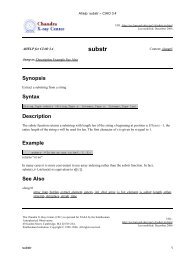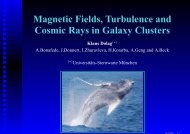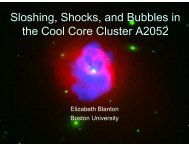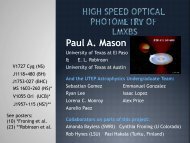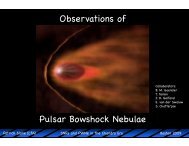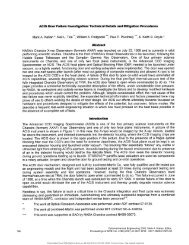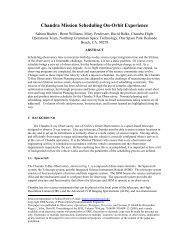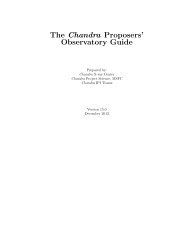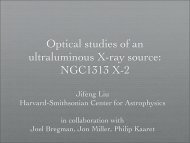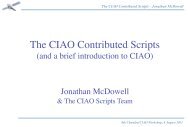PDF Version - Chandra X-Ray Observatory (CXC)
PDF Version - Chandra X-Ray Observatory (CXC)
PDF Version - Chandra X-Ray Observatory (CXC)
Create successful ePaper yourself
Turn your PDF publications into a flip-book with our unique Google optimized e-Paper software.
Spring, 2012<br />
events, they are filtered out onboard. Gain droop though<br />
has meant that the pulse heights of the lowest energy photon<br />
events are now beginning to merge with the background<br />
signal and some some are not being telemetered.<br />
In order to remedy this, we need to raise the detector<br />
gain—a face lift for the sagging. The gain can be increased<br />
by raising the high voltage between the front and rear<br />
plates, enhancing the electron cascade. It is not a trivial<br />
exercise however: taken too far, the high voltage could result<br />
in breakdown and arcing, potentially destroying the<br />
instrument. How did it turn out? See the HRC article on<br />
page 10 to find out.<br />
2. Learning Curve<br />
The LETG+HRC-S effective area curve relies,<br />
more than any of <strong>Chandra</strong>’s other instruments, on inflight<br />
calibration using cosmic X-ray sources. <strong>Chandra</strong> was<br />
largely calibrated on the ground over many weeks through<br />
an extensive military-stye operation directed by Generals<br />
Weisskopf and Tananbaum at the MSFC X-ray Calibration<br />
Facility (XRCF). The best calibration data came from<br />
electron impact point sources (EIPS) in which an electron<br />
beam is accelerated onto an anode with sufficiently high<br />
voltage to excite “K-shell” transitions through removal of<br />
1 s electrons. The X-ray spectrum of such a source usually<br />
has a nice bright K-line on top of a weaker continuum—<br />
a reasonable approximation to a monochromatic X-ray<br />
source (though the full X-ray spectral energy distribution<br />
generally had to be taken into account in analysis).<br />
The problem is that the energy spacing of K lines is rather<br />
sparse—C K at 0.28 keV, B at 0.18, Be at 0.11—and the<br />
HRC-S QE was not necessarily so slowly varying with energy<br />
that we could just join up the dots between the sparse<br />
measurements with straight lines.<br />
XRCF was equipped with good monochromators<br />
that could be operated with continuum sources to select<br />
out nearly monochromatic X-rays of the desired energy.<br />
But the refections inside the monochromators tended to<br />
produce an X-ray beam that was not nearly as uniform as<br />
the beam from the EIPS alone. The calibration method, in<br />
essence, was to compare the detected signal in <strong>Chandra</strong>’s<br />
instruments with beam flux measured both at the telescope<br />
aperture and at some distance up-beam. The beam uniformity<br />
mattered because these beam measurements were<br />
spot measurements made by 4 flow proportional counters<br />
at the mirror entrance and one up-beam—again a problem<br />
of how to join the dots between the sparse measurements.<br />
In addition to these difficulties, the final in-flight high<br />
voltage settings of the HRC-S were optimized to slightly<br />
different values to those employed in ground calibration<br />
leading to expectations of different quantum efficiency between<br />
ground and flight conditions.<br />
15<br />
In Newsletter 13, I described some of the initial<br />
in-flight calibration of the LETGS based on hot white<br />
dwarf spectra (see Pease et al. (2000) for a more detailed<br />
description). <strong>Chandra</strong>’s low energy monitoring “standard<br />
candle” is the hot white dwarf HZ43. With a temperature<br />
of about 50,000 K, it is sufficiently hot to produce useful<br />
signal in the LETG+HRC-S down to about 50 Å or so. But<br />
as a single star, its surface gravity relied on spectral modelling<br />
in the UV-optical range. White dwarf X-ray fluxes are<br />
very sensitive to both the assumed effective temperature,<br />
and the surface gravity, and so a white dwarf with a better<br />
known mass was enlisted to help: Sirius B. The initial<br />
LETGS low energy in-flight calibration was, then, based<br />
on the spectra of HZ43 and Sirius B. Using the best models<br />
and stellar parameters of the day they did not quite agree<br />
where they overlapped though, and we had to do some<br />
guesswork to merge the two spectra and obtain what we<br />
thought was the best “average” effective area curve.<br />
Subsequent years saw some improvements in<br />
the atmospheric models and in understanding the stellar<br />
fundamental parameters, and defects in the effective area<br />
model became apparent. The shorter wavelengths were recalibrated<br />
using blazar spectra, taking advantage of overlap<br />
and cross-calibration with the HETG and ACIS-S detector—see<br />
Newsletters 16 and 17. Some foundations for<br />
a re-calibration at longer wavelengths using HZ43, Sirius<br />
B, and even assuming the spectrum of the isolated neutron<br />
star RXJ 1856 − 3754 might be a pure blackbody, were<br />
made by colleagues at LETG PI institutes MPE and SRON<br />
by Bauermann et al. (2006) and Kaastra et al. (2009). PhD<br />
student Benedikt Menz and long-time colleague Vadim<br />
Burwitz pioneered including another hot white dwarf,<br />
GD153, into the mix. With an effective temperature of<br />
39000 K the latter bridges the effective temperature gap<br />
between HZ43 and Sirius B.<br />
One result of all this work we took advantage of<br />
here was a growing confidence in parameters for HZ43<br />
and that its spectrum was well-represented by pure hydrogen<br />
atmospheric models. We found that by co-adding<br />
10 years’ worth of HZ43 calibration data obtained since<br />
launch enabled us to obtain useful signal down to the C K<br />
edge, meeting up with our earlier blazar calibration. This<br />
offered a promising approach: the much cooler Sirius B<br />
X-ray model fluxes always seemed worryingly sensitive<br />
to fine details of the model atmosphere calculations and<br />
a calibration based on a single reference source—HZ43—<br />
held immense Occam’s razor-like appeal. IT Specialist Nick<br />
Durham carefully accounted for the secular HRC-S QE decline,<br />
and reprocessed the data what must have seemed to<br />
him like several hundred times to account for small ∼1%<br />
level tweaks and perfections in things like higher order<br />
contributions, extraction efficiencies and HRC deadtime



